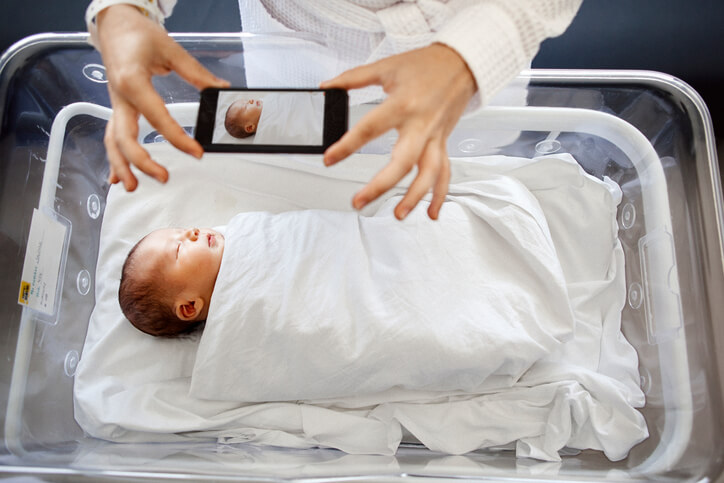Whether you’re just starting your surrogacy journey or you are in the midst of your surrogate pregnancy, your excitement to be a surrogate is likely something that you want to shout from the rooftops. More than ever before, surrogates today have great opportunities to spread awareness of and share their surrogacy story with friends, family and strangers — and you can do so, too.
So, how exactly can you share your surrogacy story? How do you know what to share and what not to share?
When in doubt, we encourage you to contact your surrogacy specialist at 1-800-875-BABY(2229) for guidance. But, to help get your thoughts going, we’ve offered a few suggestions below.
First: Check with Your Intended Parents
Before you decide to share any aspect of your surrogacy story, it’s important that you speak with your intended parents. They are just as much a part of your surrogacy story as you are, and you will need to make sure both parties are comfortable with what information will be shared with friends, family and strangers. Surrogacy is a very intimate partnership; some intended parents may be less likely than others to share their personal journey.
When you first start your surrogacy journey, ask your surrogacy specialist about mediating a conversation about social media and personal information. Your specialist can help you and your intended parents come to an agreement about the level of detail shared by each other. This is an important step in creating a respectful, solid relationship moving forward.
Before signing your surrogacy contract, make sure that this issue is properly addressed by all members of the surrogacy journey.
How to Share Your Surrogacy Story
Once you and the intended parents have decided what to and what not to share with other people, you can move forward with sharing your surrogacy story in the way that works best for you. Which steps you take can also play a part in documenting your surrogacy story for yourself for later.
As a surrogate, you are entering a role in which you have a responsibility to educate others about the surrogacy process. There is a lot of misconception out there about how surrogacy works and, by sharing your story, you can take the steps to help others understand the reality of the process.
Every surrogate is different, which means how you share your story will always be up to you. Here are a few suggestions if you’re wondering how to get the word out about your surrogacy experience:
- Use social media.
While it does come with downsides, social media is by far the best way to communicate ideas to a large number of people. If you choose to share and document your surrogacy journey on your social media, you can let people into the intimate details of your surrogacy story — providing a better overall view of the surrogacy process from someone they know and trust.
Social media also provides an opportunity for people to easily ask questions about surrogacy — without having to go far to find the information they want. If you and your intended parents are comfortable doing so, don’t be afraid to share photos, videos, personal stories and more before, during and after your pregnancy.
As you are posting on social media, you can further connect with other intended parents, surrogates and surrogacy professionals by using hashtags. Use phrases like #surrogacy, #fertility, #infertility, #surrogates and more to share your story with an even wider audience. And make sure to share your story with us at our Instagram page!
- Use a photo-sharing app.
Sometimes, surrogates and intended parents don’t want to share photos with everyone on the internet — and that’s okay. Instead, you can use secured methods of sharing photos, like Shutterfly or Dropbox or an app like 23snaps. This way, you can share the photos with only the people you want, whether that’s a wide range of family members and friends or just the intended parents. Uploading photos to these sites can also easily document your surrogacy journey and provide a way for you to look back on the experience later.
- Join an online support group.
Odds are, before you became a surrogate, you participated in online support groups and forums to learn more about the realities of being a surrogate. Once you become a surrogate, take that chance to give back in the same way — by answering hopeful surrogates’ questions, chiming in on bigger issues and overall sharing your story for those who will most be interested in hearing it. As long as you keep the disadvantages of online support groups in mind, you can share and tell a great deal of helpful information on these kinds of sites.
- Keep a blog — or volunteer a blog post.
If you like writing, creating a blog may be the best way for you to share your story. You can start whenever you want in your surrogacy journey, and your words will mean a lot to the women and parents who are considering the surrogacy process. If you don’t wish to maintain a constant blog, consider reaching out to a surrogacy website (American Surrogacy included) to share a blog post about a topic that is important to you.
- Share your experiences in real life.
Just as you should be open to answering questions and educating people online, you should do the same in-person. Make sure your friends and family are aware of your surrogacy from early on, and don’t be afraid to bring up your recent experiences during your surrogacy process. Don’t wait until it’s too late; you don’t want to answer the awkward question of “Where is the baby?” after you give birth.
- Create a surrogacy memory book.
There’s another important person with whom you may wish to share your surrogacy journey: the child you are giving birth to. To help them understand your surrogacy story down the line, you may work on a surrogacy memory book right now. This memory book can include photos from your pregnancy and delivery, letters you’ve written to the child, and more.
Before you work on this, make sure you speak with the intended parents to ensure their comfort in you doing this — and to see whether they wish to include any memories of their own!
- Share your story with your surrogacy professional.
Finally, recognize that your surrogacy story can be incredibly helpful to intended parents and surrogates considering this journey. At American Surrogacy, we offer the opportunity for surrogates to tell their story as part of a testimonial. These stories have been instrumental for those considering surrogacy, and it’s a fairly easy process to complete. To learn more, we encourage you to contact your surrogacy specialist today.





